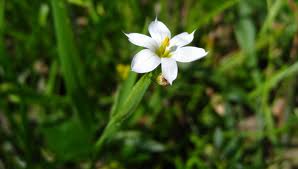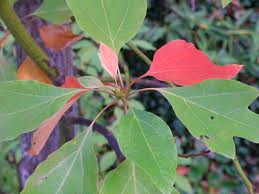Sassafras
Three types of leaves are found and many times on the same branch; one kind is simple or whole (having no lobes), the second kind has 3-lobes and the third kind has 2-lobes making them look like little mittens. The leaves are smooth and bright green above and paler and slightly fuzzy beneath. They grow from 3 to 6 inches in length and 2 to 4 inches across. In the fall, the outer leaves turn orange and red, while the inner leaves turn yellow. In the spring, 2-inch clusters of tiny, fragrant, yellow flowers are borne. Male and female flowers are produced on separate trees. The flowers on the female trees are followed by inedible, glossy dark blue, berry-like fruits. The berries grow on bright red stems. This tree is very aromatic and at one time was valued for its medicinal properties. Sassafras tea can be brewed from the bark of its roots and oil can be distilled from the bark and be used to flavor candies and medicine and give fragrance to soap. The young leaves and the pith of the branchlets are very mucilaginous and when dried and powdered can be used like gumbo to thicken soups. The wood of this tree is soft, weak, brittle, aromatic, and durable when in contact with the soil. It is used for posts and furniture. S. Tzumu, the Chinese kind, isn't as hardy as the American Sassafras and can only be grown in mild climates.
Pot Cultivation
Sassafras trees flourish in moist, light, fertile soil that is deep enough to accommodate its long roots. When they are grown in the North, they should be placed in a warm, sheltered, sunny spot; this isn't as important in the South. These trees are difficult to transplant when they are large because they have long taproots and sprawling root systems. Trees that are bought balled and burlapped should be planted in early spring. Pruning should be done in the winter, but any suckers or shoots that spring up from the tree should be cut away as soon as they appear.Propagation
These trees are easily increased by sowing seeds and by suckers, which freely grow under established trees. |
 |
S. albidum |
S. Tzumu |
VARIETIES
- S. albidum;
- S. Tzumu.




